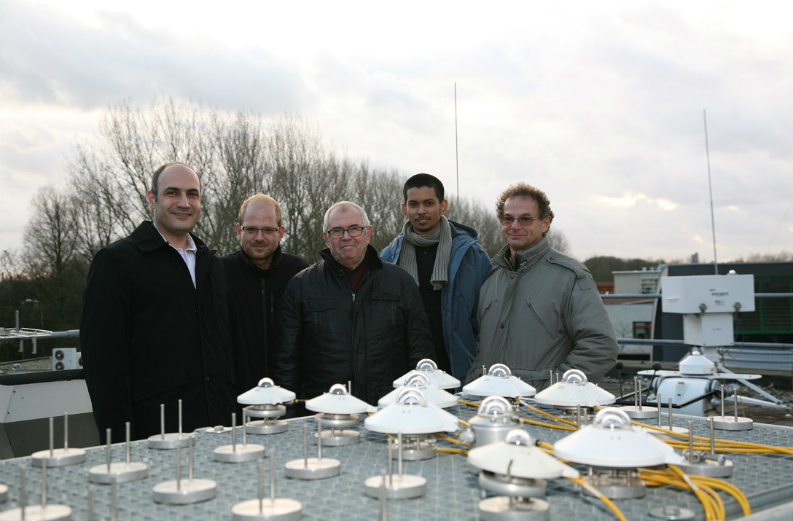M. Olivier Delage is the Project Manager of GEO_SUN at the Laboratory of Energy, Electronics and Processes (LE2P) at the university and the members of his team were M. Patrick Jeanty, Research Engineer ; Alexis Heintz, Meteorology Engineer and Jean-Daniel Cazal, Meteorology Technician. Kamal Sabra, the Manager of Kipp & Zonen S.a.r.l. in France joined the Réunion party for their visit in December 2014 when we asked them about their journey to establish a BSRN station.
What brings you to Kipp & Zonen?
We have started a project called GEO_SUN that includes the setup of a Baseline Surface Radiation Network (BSRN) station. The scope of the project is a geoscience collaboration between South Africa and our island of La Réunion. The Southern African Universities Radiometric Network, SAURAN, uses the SOLYS 2 sun tracker and Kipp & Zonen pyranometers, pyrgeometers and pyrheliometers. We came to the manufacturer to learn all about BSRN because we would like to have the same equipment in La Réunion. It is all very robust and precise and meets the requirements of BSRN.
The aim of the GEO_SUN project is:
- building a database to manage the increasing volume of information
- supporting decision making in solar energy projects
- joining the BSRN climate research and satellite validation programmes
We currently have a network of 12 entry-level pyranometers on automatic weather stations spread around the Island. All the data is uploaded to our server and available on-line.
Moreover, we have our own Kipp & Zonen calibration facility for pyranometers. Once we have installed the BSRN station we will compare the measurements of the existing network of pyranometers, so scientific communities will have the possibility of characterisation.
What initiated the GEO-SUN project?
Because we are an island La Réunion’s energy supply is not very secure, as we currently rely on imported coal and oil for two thirds of our electricity generation. Most of the rest comes from hydroelectric and biomass plants. 5 years ago the French government and Électricité de France (EDF) decided to limit the maximum amount of variable renewable energy (wind and solar) fed into the grid to 30% to maintain the base-load supply. This had a large impact on the local solar energy business. As one of the labs investigating and measuring solar radiation, we were asked to find solutions to reduce the variability risk.
What we proposed is storage. If you can store the power generated by solar energy you can use it whenever you need it Another solution we offered is to predict more accurately how much power can be generated on the next day by monitoring incoming solar irradiance. EDF choose to work with this option and for their next big power plant they agreed to provide a forecast one day in advance.
Providing the forecast of expected solar production requires a higher level of instrumentation. We want to be able to cross-reference our knowledge and data with other networks and universities. We will improve satellite data with ground measurements and we are in the process of commissioning our SAURAN station.
What are your next steps in the preparation of the BSRN station?
Alongside the training here at your office we have made a field trip to visit an operational BSRN station in the Netherlands to learn from an experienced organisation. Next we will visit another BSRN station, near Paris, and we also travelled to South Africa two weeks ago to meet our colleagues in SAURAN.
Already we have a clearer picture of what equipment to buy to establish a BSRN station and we have also learned a lot about maintenance and site requirements. With the insights acquired we feel confident to manage the right equipment, to train people and to set out our working methods. Applying for BSRN membership is a lengthy process but we expect to have the station up and running in two years. After that we plan to spread our GEO_SUN project to Madagascar, Mauritius, the Seychelles and further.
It is interesting to share that nobody has ever measured solar radiation for solar energy on La Réunion. Global models consider the island as one single spot with no spatial resolution. But, they don’t realise that our climate is very different from Europe/ We have micro-climates, extreme winds, hurricanes, varying topography and Piton de la Fournaise, one of the World’s most active volcanoes. With our project we will be able to down-scale the energy models and also study if there is a change in climate occurring on La Réunion.
How was your visit to the Netherlands?
It was a great experience to visit Kipp & Zonen and receive all the information on BSRN and solar radiation measurement from your experts. We have gained so much more knowledge and understanding. These were three very useful days. We couldn’t have started in a better way. Staying on our island was not an option; we really wanted to see with our own eyes how it works.

Find out more about the Laboratory of Energy, Electronics and Processes at l’Université de La Réunion by going to http://www.le2p.fr. To build their BSRN station they have acquired a SOLYS Gear Drive sun tracker as the base.
There is an article about The Southern African Universities Radiometric Network, SAURAN, in our Newsletter 31 published in January 2015.